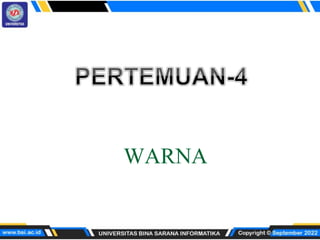
0066-P04.pdf
- 1. WARNA
- 2. Warna Warna sebenarnya merupakan persepsi kita terhadap pantulan cahaya dari benda-benda. pantulan persepsi warna
- 3. Cahaya Cahaya merupakan energi elektromagnetik Cahaya dapat dibagi menjadi dua bagian : Cahaya terlihat (visible light) yaitu bagian dari energi elektromagnetik dengan panjang gelombang 400-700 nm (nanometer) Cahaya tidak terlihat (invisible light) yaitu bagian dari energi elektromagnetik dengan panjang gelombang < 400 nm atau > 700 nm Mata manusia hanya peka terhadap panjang gelombang 400 - 700 nm dan perbedaan panjang gelombang tersebut dipersepsikan sebagai 'warna'
- 5. Bagaimana manusia melihat warna ? Bagian mata yang sensitif terhadap cahaya disebut sebagai retina, retina berisi dua macam kelompok sel yaitu : rod dan cone
- 6. Bagaimana manusia melihat warna Rods Hanya dapat membedakan terang dan gelap (hitam / putih) Mata mempunyai 120 juta rod Tidak sensitif terhadap warna Cones Bagian retina yang peka terhadap warna Mata mempunyai 60 juta cones Ada tiga macam cones, masing-masing peka terhadap warna merah (L), biru (S) dan hijau (M). Dapat membedakan 200 warna sekaligus
- 7. Bagaimana manusia melihat warna? Fovea adalah arena di retina yang berisi cones Berukuran 1/150 inch Fovea hanya mempunyai sudut pandang sebesar 1,7 derajad. Diluar itu gambar terlihat kabur. Setiap cones di fovea mempunyai satu jalur syaraf ke otak dan dapat mengirim 'gambar' sekaligus (paralel) Bandingkan : Video Kamera mempunyai 400.000 sensor tetapi hanya dapat mengirim 'gambar' satu persatu (stream)
- 9. Bagaimana warna dibuat ? Warna dapat diproduksi berdasarkan dua cara : Substractive Colour Additive Colour Substractive : warna dihasilkan sebagai akibat dari diserapnya warna tertentu. Tinta cetak Additive : warna dihasilkan sebagai campuran dari warna yang dipancarkan oleh sumber cahaya. Monitor
- 10. Representasi warna di komputer Ada berbagai cara untuk menghasilkan warna menggunakan komputer. Beberapa model warna yang digunakan antara lain : RGB HSV / HSB HLS CMY(K) CIE
- 11. RGB (Red, Green, Blue) Warna diperoleh dari campuran tiga warna dasar (primary color), yaitu : Red, Green, Blue Setiap komponen warna disimpan sebagai angka dari 0-255 (0-FF), dengan 0 = tidak ada komponen 255 = komponen digunakan penuh R = 0 G = 255 B = 0 R = 0 G = 0 B = 255 R = 255 G = 128 B = 128 R = 128 G = 255 B = 255 R = 128 G =75 B = 0 R = 255 G = 0 B = 0
- 12. CMY(K) / Cyan, Magenta, Yellow, Black Menggunakan warna dasar (primary color) : Cyan, Magenta, Yellow dan Black. Warna lain diperoleh karena campuran warna dasar menyerap warna dasar dan memantulkan warna yang diinginkan. Warna Tinta Menyerap Memantulkan Terlihat Cyan Merah Biru dan Hijau Sian Magenta Hijau Merah dan Biru Magenta Yellow Biru Merah dan Hijau Kuning Magenta+Yellow Hijau dan Biru Merah Merah Cyan + Magenta Merah dan Hijau Biru Biru Cyan + Yellow Merah dan Biru Hijau Hijau
- 13. RGB dan CMY(K) Catatan : warna merah disembunyikan
- 14. HSV/B (Hue, Saturation, Value / Brightness) HSB merupakan sistem warna yang menggunakan ukuran : Hue : warna yang diinginkan, diukur dengan nilai 0o - 360o, dengan 0o = red,12o=green, 240o=blue Saturation : keaslian warna, diukur dengan nilai 0% - 100%. Nilai 0 menyatakan warna putih dan 100% menyatakan warna asli Value / Brightness : pengaruh kecerahan, 0% menyatakan tidak ada cahaya (hitam) dan 100% menyatakan warna putih.
- 15. HLS (Hue, Lightness, Saturation) Menggunakan ukuran : Hue : warna yang diinginkan, diukur dengan nilai 0o - 360o, dengan 0o = red,12o=green, 240o=blue Lightness : pengaruh warna putih, nilai maksimum Lightness menyatakan warna putih sedangkan nilai minimum menyatakan warna hitam. Saturation : keaslian warna, diukur dengan nilai 0% - 100%. Nilai 0 menyatakan warna putih dan 100% menyatakan warna asli
- 16. CIE CIE (Commission Internationale d'Eclairage) mendefinisikan tiga sumber cahaya hipotetis x,y,z yang menggunakan kurva positif dari spektrum